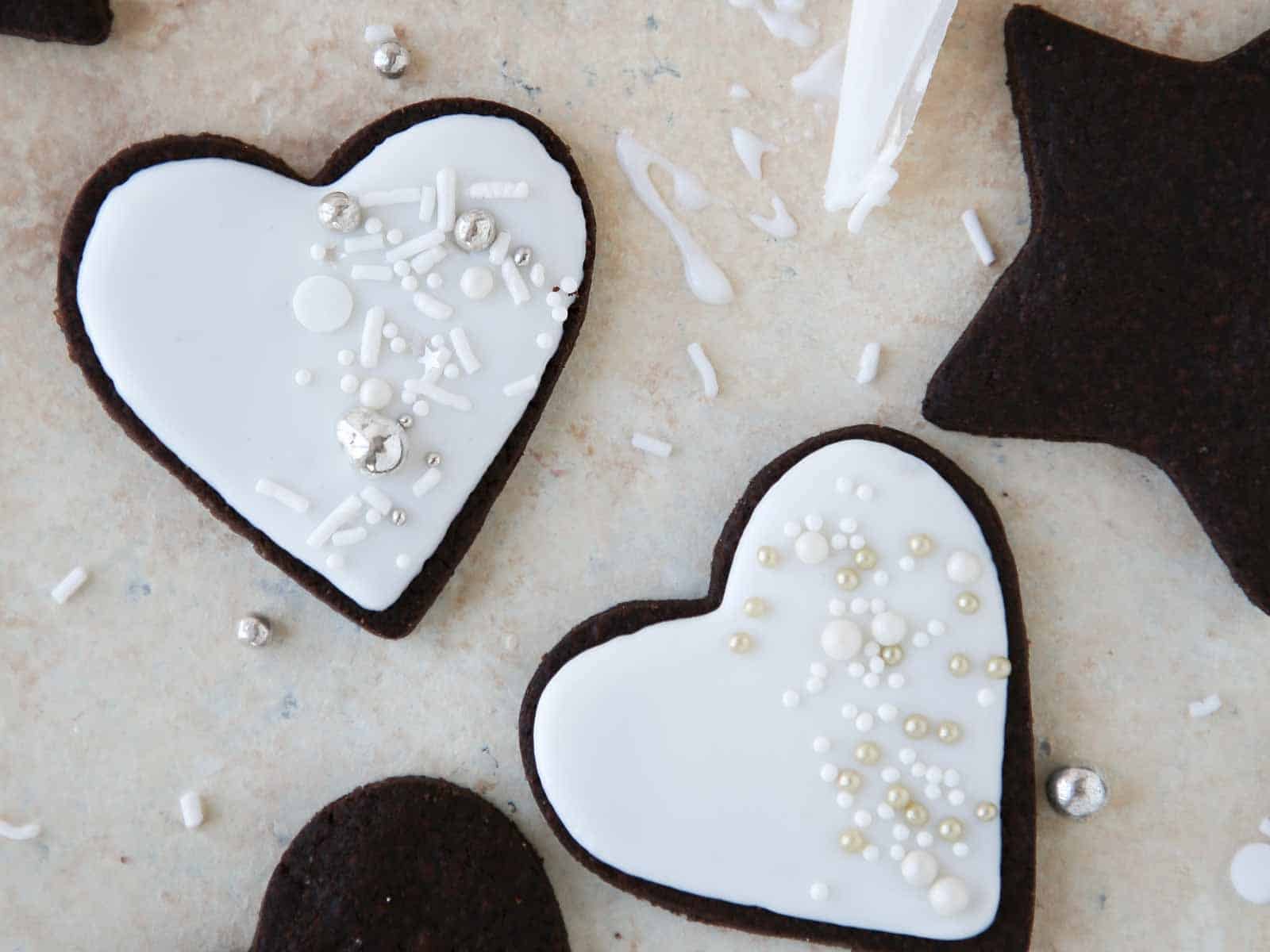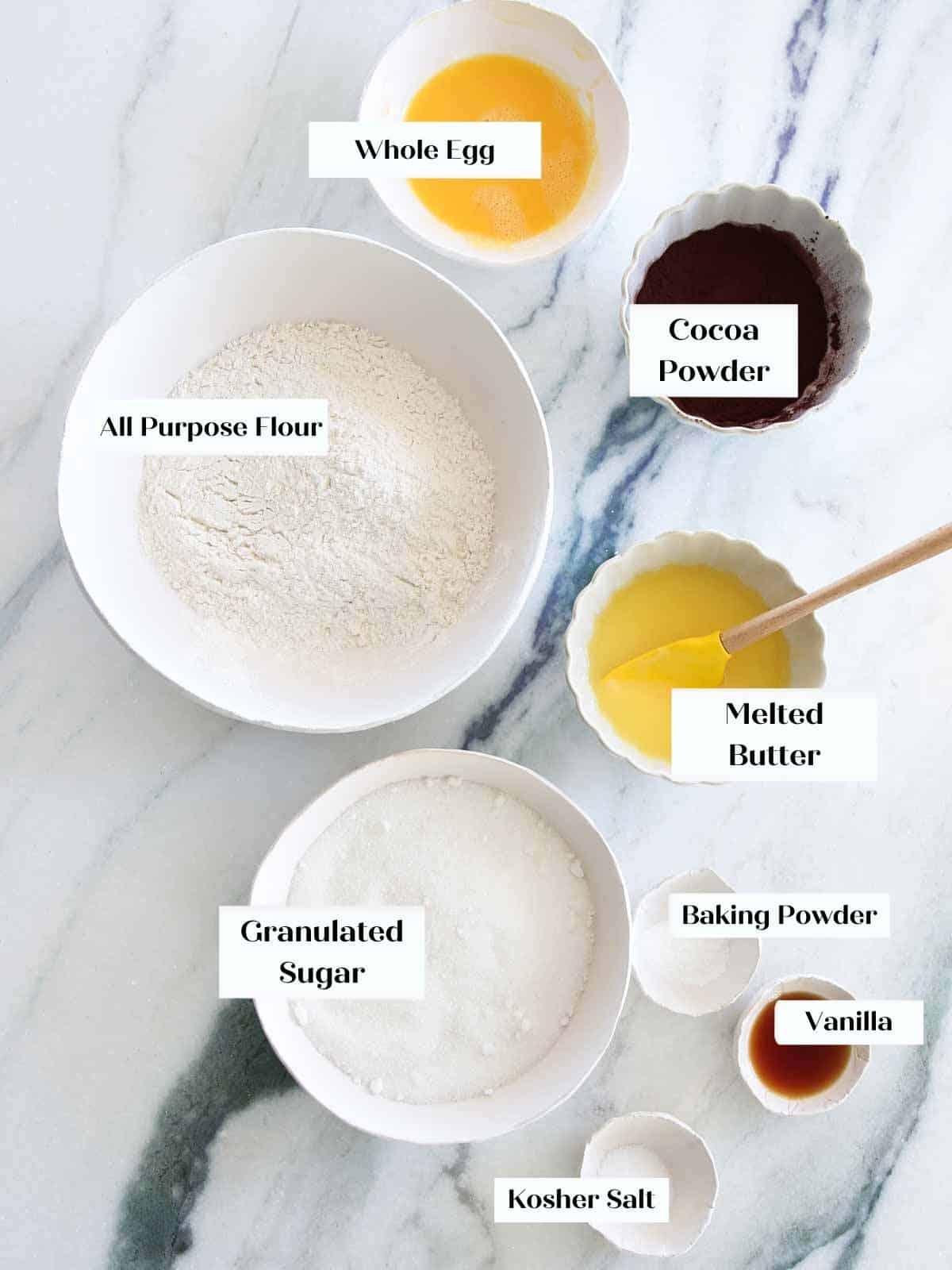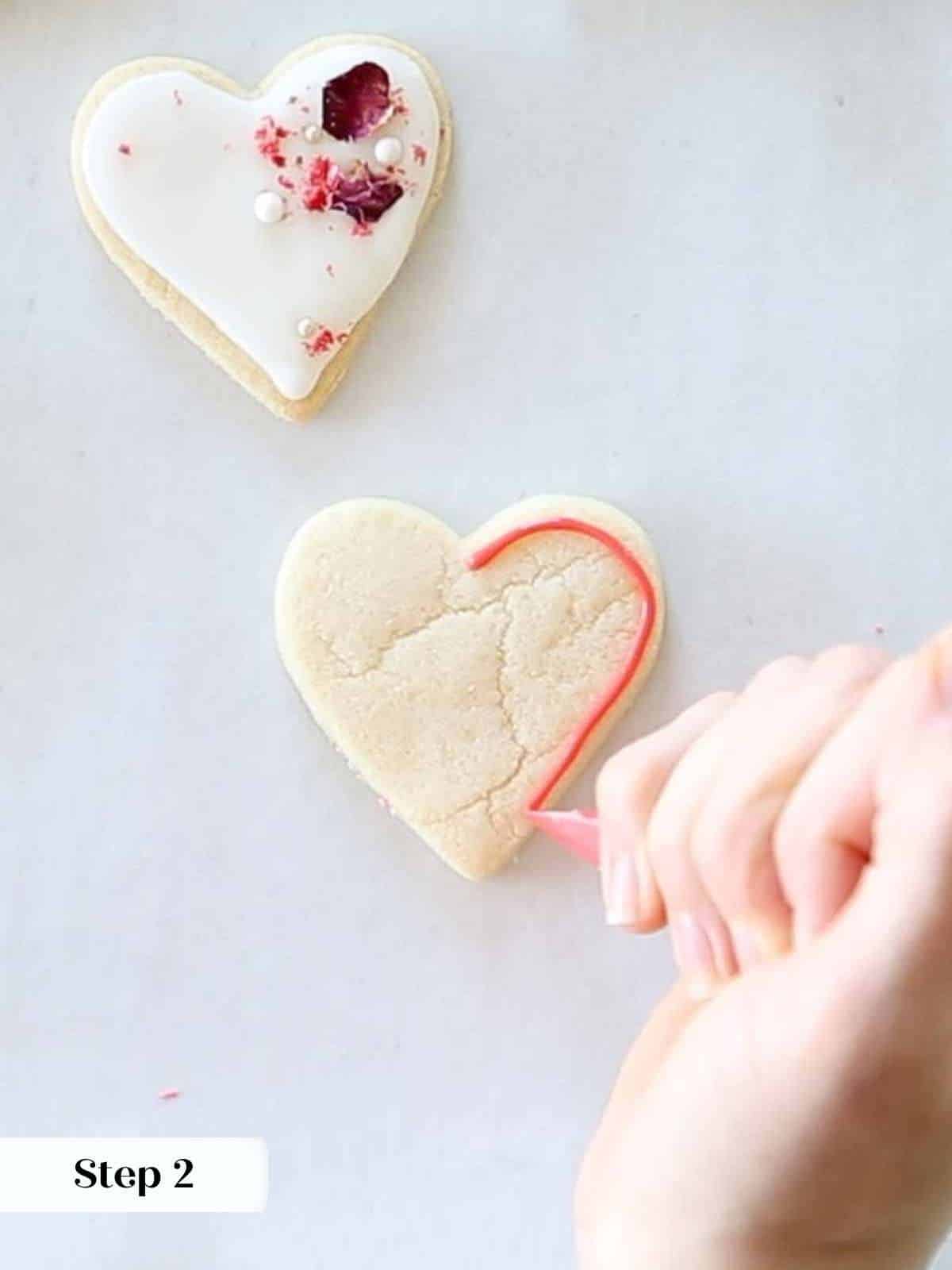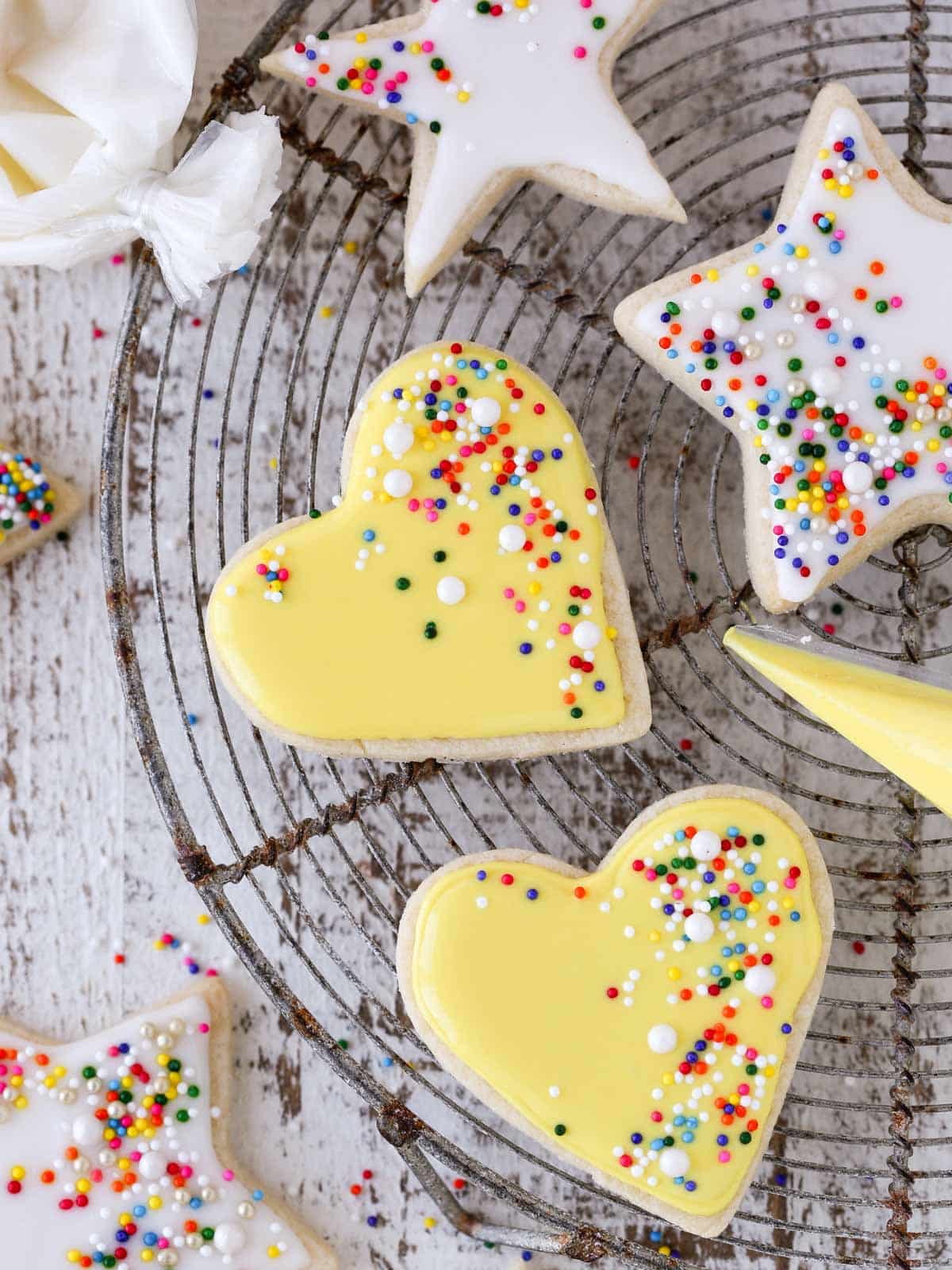Mastering Chocolate Sugar Cookies: Easy Recipe & Decorating Tips for Any Occasion
Delight in the rich, deep flavor of these soft, rolled chocolate sugar cookies, perfectly crafted for decorating. Paired with my easy cookie icing, these cookies are a joy to make, offering an intensely chocolatey bite that will impress everyone. Unlike many sugar cookie recipes, these maintain their shape beautifully without spreading or puffing excessively during baking, ensuring your intricate designs stay picture-perfect.

These chocolate sugar cookies strike the perfect balance between soft and slightly chewy. They bake consistently flat and hold their intricate shapes, making them ideal for any cookie cutter design. The dough itself is incredibly straightforward to prepare, coming together effortlessly in a single bowl using either melted butter and a whisk or a stand mixer. You’ll find their texture reminiscent of my popular soft cut out sugar cookies, but with the luxurious, deep cocoa notes characteristic of my chocolate thumbprint cookies.
While I’ve adorned these charming heart-shaped cookies with my easy cookie icing, their versatility shines through with various frostings. They are equally delightful with elegant royal icing or a tangy cream cheese frosting for cookies. The decorating possibilities are truly limitless! Grab any cookie cutter you desire and transform these delicious treats into festive delights for occasions like Valentine’s Day, Weddings, Mother’s Day, Christmas, Halloween, or even the patriotic celebrations of July 4th!
Table of Contents
- Why You Will Love These Chocolate Sugar Cookies
- Professional Tips for Making Classic Chocolate Cookies
- Ingredients for Perfect Chocolate Sugar Cookies
- Possible Variations for Your Chocolate Sugar Cookies
- How to Make this Chocolate Sugar Cookie Recipe
- Chef Lindsey’s Recipe Tip for Icing
- Frequently Asked Questions About Chocolate Sugar Cookies
- Chocolate Sugar Cookies Recipe Card
- Before You Go: More Delicious Recipes
Why You Will Love These Chocolate Sugar Cookies
- Effortless to Mix and Roll: Say goodbye to messy flour-dusted countertops! This dough is a dream to work with. It mixes quickly in one bowl and can be rolled out perfectly between two sheets of parchment paper, eliminating the need for extra bench flour that can dry out your dough. With only a brief 30-minute chilling period before cutting and baking, you’ll have beautifully shaped cookies in no time.
- Deep, Rich Chocolate Flavor: These aren’t just any chocolate cookies; they boast a truly profound and rich chocolate taste. We use just the right amount of high-quality unsweetened cocoa powder to achieve a deep flavor without any hint of bitterness. Enhanced with a touch of kosher salt and pure vanilla extract, each bite is a perfect symphony of chocolatey goodness. Many describe them as having a flavor profile similar to decadent fudgy brownies or my beloved brownie cookies.
- Limitless Decorating Options: The true magic of this recipe lies in its ability to hold shape perfectly during baking. This means your intricate designs will remain sharp and defined. Whether you’re planning an elaborate holiday spread or a simple batch of everyday treats, choose any cookie cutter that suits your theme and let your creativity run wild. Decorate them as ornately or as simply as your heart desires, knowing they’ll always look fantastic.

Professional Tips for Making Classic Chocolate Sugar Cookies
- Always Roll Between 2 Sheets of Parchment Paper: This is a game-changer for sugar cookies, especially chocolate ones. Rolling dough directly on a floured surface, or even a cocoa-dusted one, can incorporate too much dry ingredient, leading to tough and crumbly cookies. Parchment paper eliminates this issue entirely, keeping your dough moist and pliable. It also makes transferring and cutting chilled dough incredibly easy and mess-free.
- Chill the Dough *After* Rolling: Many recipes instruct you to chill the dough, then roll it. For cut-out cookies, a more efficient and effective method is to mix the dough, roll it to your desired thickness immediately while it’s still soft and workable, and *then* chill it. This approach ensures you get wonderfully sharp edges on your cookies. Cold dough becomes brittle and firm, which is essential for precise cuts, but it’s much harder to roll evenly. Rolling it when pliable and then chilling results in the best of both worlds.
- Opt for Dutch-Processed Cocoa Powder for Ultimate Richness: While any good quality cocoa powder will yield a tasty cookie, Dutch-processed cocoa powder is the secret weapon for achieving the deepest, richest chocolate flavor and a beautiful dark color in these cookies. Dutch-processing neutralizes cocoa’s acidity, resulting in a smoother, less bitter, and more intense chocolate taste that truly elevates these sugar cookies.
Ingredients for Perfect Chocolate Sugar Cookies
Crafting delicious chocolate sugar cookies starts with understanding the role of each ingredient. Here’s a closer look at what you’ll need and why:

- All-Purpose Flour: This versatile flour provides the necessary structure for our cookies. Its moderate protein content allows for just enough gluten development to create a sturdy, yet tender, cookie that holds its shape beautifully without becoming tough. Both all-purpose flour or pastry flour would work perfectly in this recipe, offering a soft crumb.
- Dutch-Processed Cocoa Powder: This is where the magic happens for our intense chocolate flavor. Choosing a high-quality brand like Valrhona or Ghirardelli is crucial for a rich, robust flavor and a deep, appealing color. Dutch-processed cocoa powder has been treated to reduce its acidity, resulting in a smoother, less bitter, and more profound chocolate taste.
- Baking Powder: Our leavening agent. A carefully measured amount of baking powder ensures these cookies are soft without becoming overly puffy. Using too much baking powder or substituting with baking soda can cause the cookies to dome or spread excessively, which we want to avoid for perfectly flat decorating surfaces.
- Kosher Salt: Don’t underestimate the power of salt! It plays a vital role in balancing the sweetness of the sugar and intensely enhancing the rich chocolate flavor, making every bite more complex and delicious.
- Butter: I always recommend using unsalted butter for baking, as it gives you complete control over the total salt content in your recipe. Melted butter in this recipe contributes essential fat and moisture, which are key to achieving that wonderfully chewy and soft texture that makes these simple cookies so irresistible. Ensure it’s melted but not hot, to avoid scrambling the egg.
- Granulated Sugar: The granulated sugar is precisely measured to provide the ideal level of sweetness without causing the cookies to spread too much. Unlike recipes for chewy sugar cookies, which are designed to spread, these chocolate sugar cookies are specifically formulated to hold their shape, making them perfect for intricate cut-out designs.
- Whole Egg: The whole egg acts as a binder, adding crucial fat and moisture to the dough while also helping to emulsify the ingredients. The fat from the yolk contributes significantly to the cookies’ richness and helps keep them delightfully chewy.
- Pure Vanilla Extract: A classic flavor enhancer, vanilla extract beautifully complements and deepens the chocolate notes, adding a layer of aromatic complexity to these delicious cookies.
For precise quantities and a complete nutritional breakdown, please refer to the comprehensive recipe card below.
Possible Variations for Your Chocolate Sugar Cookies
One of the best things about this chocolate sugar cookie recipe is its incredible adaptability! Once you master the base cookie, you can unleash your creativity with various flavor and decoration enhancements:
- Experiment with Icing and Toppings: Beyond the easy cookie icing, there’s a world of possibilities! Try a rich cream cheese frosting for cookies for a tangy contrast. For a sophisticated look, simply brush the baked cookies with a beaten egg white wash and dip them in sparkling sanding sugar or a medley of colorful sprinkles before baking. For a soft, less structured finish that’s still incredibly delicious, use my best chocolate buttercream or a classic vanilla buttercream – just remember they won’t stack well until fully set! For an extra boost of chocolate, dip cooled cookies in tempered melted chocolate.
- Infuse the Dough with Exciting Flavors: Elevate the chocolate base by adding extra flavorings directly into the dough. For a bright, citrusy note, finely zest a lemon or orange directly into the granulated sugar before mixing with the butter. This ingenious trick disperses the essential oils beautifully without introducing unwanted moisture to the dough. Craving a mocha flavor? Substitute 1 teaspoon of coffee extract for the vanilla, or add a pinch of espresso powder to the dry ingredients for a subtle coffee kick that enhances chocolate. Peppermint extract is also wonderful for a holiday twist!
- Incorporate Sprinkles, Chocolate Chips, or Other Mix-ins: Absolutely! Don’t shy away from adding fun elements directly into the cookie dough itself. Mini chocolate chips, finely chopped nuts (like pecans or walnuts), or even festive sprinkles can be gently folded into the dough. The key is to use smaller add-ins that won’t interfere with the rolling and cutting process, ensuring your cookies still hold their beautiful shape.
How to Make this Chocolate Sugar Cookie Recipe
Follow these detailed instructions to create perfectly decorated chocolate sugar cookies that are as delightful to look at as they are to eat! This tutorial will guide you through making the delicious chocolate cookies. For more in-depth instructions on creating different icings, you can refer to my dedicated posts on royal icing with meringue powder and easy cookie icing.
Make & Bake the Cookies:
Step 1: Begin by preparing your dry ingredients. In a medium-sized bowl, thoroughly whisk together the all-purpose flour, Dutch-processed cocoa powder, baking powder, and kosher salt. Whisking ensures these ingredients are evenly distributed, which is crucial for uniform cookies. Set this mixture aside. In a separate large bowl, gently melt the unsalted butter. You can do this in the microwave in short bursts, just until it’s melted but not hot to the touch. Hot butter can affect the texture and potentially scramble the egg.
Step 2: Into the melted butter, whisk in the granulated sugar until well combined. Next, add the whole egg and pure vanilla extract. Vigorously whisk this mixture for at least 1-2 minutes until it is fully emulsified and smooth. You should no longer see any distinct streaks of butter or egg; the mixture should appear homogenous and slightly thickened. This emulsification step is key for a consistent dough texture.
Step 3: Gradually add the whisked dry ingredients into the wet mixture, stirring slowly to combine. Be careful not to overmix at this stage.
The dough will initially appear quite dry and crumbly. To ensure all the flour is incorporated without overdeveloping the gluten (which can lead to tough cookies), I recommend finishing this step by hand. Gently squeeze the dough together with your hands until it forms a cohesive ball. This method quickly brings the dough together and helps keep it tender.
Step 4: Once the dough is ready, roll it while it is still at room temperature and pliable. Divide the dough into two equal portions. Place one portion between two sheets of parchment paper, shaping it into a flattened disk. Repeat with the second portion. This method eliminates the need for extra flour, preventing dry cookies, and makes the dough easy to handle and store.
Step 5: Working with one piece of dough at a time, use a rolling pin to roll the dough evenly to approximately ¼ inch thickness. Consistency in thickness is important for even baking. Once rolled, refrigerate both pieces of dough until they are thoroughly chilled and firm.
While the dough will be ready to cut after just 30 minutes of chilling, for the best results and to allow the gluten to fully relax, I prefer to chill the dough for a full 2 hours, or even overnight. This extended chilling time results in cookies that hold their shape exceptionally well and have a more tender bite.
Step 6: When you’re ready to bake, preheat your oven to 325° F for convection ovens or 350° F for conventional ovens. Line two baking sheets with parchment paper. Carefully peel the parchment paper from both sides of one chilled dough slab. Using your chosen cookie cutter (a heart shape is lovely!), cut out your desired shapes. For cleaner cuts, you can lightly flour your cookie cutter before each press. Arrange the cut-out cookies on the prepared baking sheets, leaving a little space between each. Once all cookies are cut, place the baking sheets back into the refrigerator for about 20 minutes to chill the cut-out shapes again. This crucial second chill helps prevent spreading in the oven.
A smart tip: you can reuse one of the pieces of parchment paper that you used for rolling the dough to line your baking sheet. Reduce waste and keep things tidy!
Step 7: Bake the cookies in your preheated oven for 7-9 minutes. Keep a close eye on them; they are done when their centers appear matte and you see a few small, hairline cracks on the surface. Be careful not to overbake, as this can lead to dry and tough cookies. Once baked, remove the baking sheets from the oven and allow the cookies to cool completely on the sheets or transfer them to a wire rack before attempting to ice or decorate them. Icing warm cookies will cause the icing to melt and run.
Make Easy Cookie Icing:
Step 1: In a large bowl, combine the powdered sugar and light corn syrup. Slowly begin to add the whole milk, whisking continuously. The key here is to add the milk very gradually, spoonful by spoonful, until you achieve the desired consistency. If you add too much milk too quickly, the icing can become too thin to work with effectively.
If you plan to use multiple colors, separate the prepared icing into different bowls before adding food dye. When coloring, always use gel food coloring for the most vibrant and concentrated colors without significantly altering the icing’s consistency. Continue to monitor the consistency carefully as you add color; some dyes can thin the icing slightly. If it gets too thin, simply whisk in a little more powdered sugar.
Step 2: For this simple powdered sugar icing, I typically use a single consistency for both outlining and flooding, which simplifies the decorating process compared to royal icing where two different consistencies are often used. To check for the correct consistency, lift your whisk or spoon from the icing: it should flow off in a thick, cohesive ribbon. This ribbon should then rest on the surface of the icing in the bowl for a moment (about 5-10 seconds) before smoothly disappearing back into the main body of icing. If the ribbon disappears too quickly, your icing is too thin; add more powdered sugar. If it doesn’t disappear at all or takes too long, it’s too thick; add a tiny drop more milk.
A crucial tip: if your icing is too thin, it won’t be opaque enough and the rich chocolate color of the cookie will show through, compromising the finished look. Always add milk slowly and err on the side of caution to maintain a beautiful, opaque finish.
Step 3: Once your icing has reached the perfect consistency and color, transfer it to piping bags fitted with a small round tip (or simply snip the end off the bag for a fine line) or clean squeeze bottles for easier handling and decorating.
How to Decorate Cookies:
Step 1: Begin by carefully cutting the very tip off your piping bag, starting with a smaller opening than you think you’ll need. Test a line on a scrap piece of parchment paper. If the line appears squiggly or uneven when you squeeze, snip a tiny bit more off the tip, making the opening just slightly larger. Continue testing and incrementally enlarging the tip until you can achieve a medium, consistent straight line with gentle pressure.
Step 2: Work with 1-3 cookies at a time to ensure the icing stays wet enough for subsequent steps. Using your piping bag, carefully trace an outline around the edge of each cookie. Aim to leave a small border, about 1/16th of an inch, inside the cookie’s edge. This slight gap prevents the icing from spilling over the sides and creates a neat, defined border.
Step 3: Immediately after outlining, switch to your “flooding” technique. Squeeze a zigzag or squiggle pattern of icing inside the outlined area across the cookie you are decorating. To smooth this out into a perfectly even layer, you can use a cake tester, a wooden skewer, or, if you’re like me and prefer a less fussy approach, simply use the clean tip of your piping bag to gently spread the icing to the edges. Lightly tap the cookie on your work surface to help the icing settle and remove any air bubbles.



The goal is for the outline and flood icing to blend seamlessly, creating one smooth, uniform surface. You should not be able to see the cookie through the icing, indicating good opacity, but the icing should not be so thin that it spills over your outline. If you find a visible line between your outline and flood, you can try gently blending them with a toothpick while the icing is still wet. Alternatively, next time, outline fewer cookies before flooding to ensure the outline doesn’t dry before you can fill it.
Step 4: For the charming wet-on-wet heart designs, as seen in these delightful Valentine’s Day Cookies, speed is of the essence. I typically decorate only one cookie at a time when employing this specific technique. Immediately after flooding your cookie with the base color, pipe small dots of a contrasting second color along the edges or anywhere you wish to create the hearts. While the icing is still wet, take a cake tester or a clean toothpick and gently drag the tip through the center of each dot. This simple motion will pull the icing, magically forming perfect little hearts!



Step 5: For other decorative styles, such as adding sprinkles or other embellishments, decorate up to 3 cookies at a time with your base icing. While the icing is still wet, liberally sprinkle on your chosen décor. The options are truly limitless: consider crushed dehydrated strawberries or blueberries for a natural, rustic look, classic sprinkles for a festive touch, elegant mini hearts, or shimmering gold jimmies for a sophisticated finish. Experiment and have fun!



Chef Lindsey’s Recipe Tip for Icing
To achieve a truly pure, crisp white icing, I always incorporate a touch of white gel food coloring into my icing along with vanilla extract for flavor. This is the only reliable method to counteract any slight yellowing from the butter or powdered sugar, ensuring your white icing is brilliantly opaque and vibrant.

Frequently Asked Questions About Chocolate Sugar Cookies
For optimal freshness and taste, store un-decorated cookies at room temperature in an airtight container for up to 3 days. However, for longer storage, I highly recommend freezing them for up to 3 months; they thaw beautifully. Once decorated with icing, these cookies can be stored at room temperature for an impressive 10 days, thanks to the icing acting as a protective seal that locks in moisture and keeps them soft. For best results after the icing has fully dried overnight, wrap individual cookies or stacks of cookies securely with plastic wrap before placing them in an airtight container.
I generally do not advise freezing cookies that have already been iced. The delicate nature of most cookie icings means they are susceptible to absorbing moisture during the thawing process. This often leads to the icing becoming sticky, discolored, and potentially bleeding into different colors, ruining your beautiful decorations. It’s best to freeze the plain baked cookies and then decorate them after they’ve thawed.
Yes, these chocolate sugar cookies are absolutely excellent for shipping! Their sturdy nature and the protective layer of icing make them quite durable during transit. The icing not only keeps them fresh for a longer period but also adds to their structural integrity, making them less prone to breaking. To ensure they arrive in perfect condition, package them snugly in a robust, closed container with ample padding. I find that placing bakery paper or bubble wrap as a cushion between layers of cookies in the tin or box offers the best protection against shifting and damage.
Crumbly dough is a common issue and usually stems from one of two reasons. Firstly, improper measurement of flour and/or cocoa powder can lead to too many dry ingredients. This is why I strongly advocate for using a kitchen scale to measure ingredients in grams for consistent accuracy. Secondly, subtle variations in the absorption properties of different brands of cocoa powder can also make the dough drier. If you find your dough is excessively crumbly and won’t come together even with gentle squeezing by hand, try adding a touch of extra melted butter (about half a tablespoon at a time) until the dough achieves a workable, cohesive consistency.
Several factors contribute to wonderfully soft cookies. Firstly, aim to bake and decorate your cookies on the same day if possible. The royal icing or easy cookie icing then plays a key role, creating a seal that helps retain moisture, keeping them soft for up to 10 days when stored in an airtight container. Secondly, it’s crucial to avoid using additional bench flour when rolling out the dough, as this will dry out the dough and result in drier, tougher baked cookies. Lastly, proper baking time is paramount: bake them just until the centers look matte and show small, faint cracks. Overbaked cookies will inevitably turn out dry and hard, losing that desirable soft and chewy texture.
If you tried this recipe and loved it please leave a 🌟 star rating and let me know how it goes in the comments below. I love hearing from you; your comments make my day!

Chocolate Sugar Cookies
Pin Recipe
Comment
Print Recipe
Ingredients
For the Cookies:
- 2 cups all-purpose flour
- ½ cup Dutch-processed cocoa powder
- ½ teaspoon baking powder
- ¾ teaspoon kosher salt
- ½ cup unsalted butter melted but not hot
- 1 ¼ cup granulated sugar
- 1 whole egg
- 2 teaspoons vanilla
For cookie icing:
- 2 cups powdered sugar
- 1 tablespoon light corn syrup
- ½ teaspoon vanilla optional
- Pinch kosher salt
- 2-3 tablespoons whole milk more as needed
Instructions
Make the cookie dough:
-
In a large bowl whisk together flour, cocoa powder, baking powder, and kosher salt. Set aside.
-
In another large bowl, melt the butter (I used the microwave) just until melted but not hot. Whisk in the sugar followed by the egg and vanilla. Whisk vigorously until the mixture is emulsified. You shouldn’t see any streaks of butter or egg.
-
Slowly stir in the flour mixture.
-
It does look like a dry dough, so I like to finish by hand, squeezing the dough together. This incorporates the flour faster without developing too much gluten.
-
Roll your dough while it is at room temperature. Divide the dough between two pieces of parchment, shape into a disl, and place another piece of parchment on top of each.
-
Roll the dough to approximately ¼ inch. You will have the best results if rolled between two pieces of parchment, but you can also roll out on a lightly floured surface.
-
Refrigerate the dough until chilled. This will only take 30 minutes, but I like to give it a full 2 hours or overnight to let the gluten relax.
Cut & bake cookies:
-
When you are ready to bake, preheat your oven to 325° F convection or 350° F conventional, and line two baking sheets with parchment paper.
-
Unstick the parchment from both sides of the dough, then cut shapes with a lightly floured cookie cutter. Chill the cookies before baking. It will only take about 20 minutes.
-
Bake in preheated oven for 7-9 minutes or until the cookies look matte in the center and have a few small cracks. I bake all the same shapes on one sheet to ensure even baking.
-
Cool completely before icing.
Make Cookie Icing:
-
In a large bowl add all the powdered sugar and corn syrup. Slowly add the milk, whisking to combine. Add milk slowly so that the icing doesn’t get too thin.
-
Separate the icing into different bowls and add food dye if desired. Be sure to keep an eye on the consistency and stop adding if it gets too thin. Gel food coloring is best for vibrant colors.
-
When decorating with this simple powdered sugar icing, I use one consistency for outlining and flooding unlike royal icing where I have two different consistencies. The icing should flow in a thick ribbon off your whisk. It should rest for a moment on the surface of the icing in the bowl before disappearing. If it is too thin, add more powdered sugar.
-
Transfer to piping bags or clean squeeze bottles.
Video
Notes
Variations – Try using lemon or orange zest in the sugar, different extracts or small mix-ins like mini chocolate chips or sprinkles.
Storage – Store cookies with icing at room temperature for up to 10 days. Allow the icing to set 24 hours before stacking, and allow it to set 3 hours before wrapping with plastic wrap (not touching the surface).
Nutrition
Before You Go: More Delicious Recipes
I genuinely hope you enjoyed this professional chef-tested recipe for perfect chocolate sugar cookies. Baking is a joy, and sharing delicious treats is even better! Be sure to explore our other delightful, chef-developed chocolate recipes. Perhaps you’ll fall in love with this rich, moist chocolate bundt cake, perfect for any gathering, or discover your next favorite among these easy chocolate dessert recipes. Happy baking!
